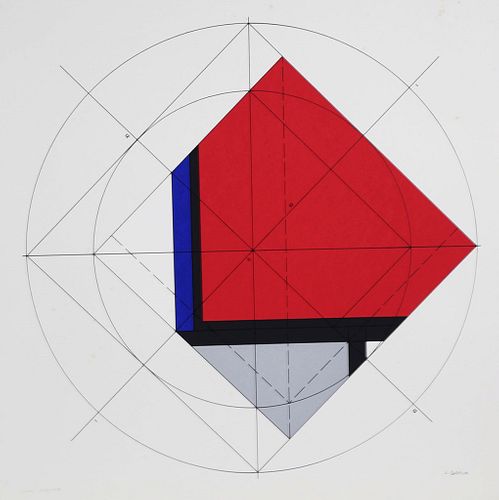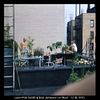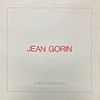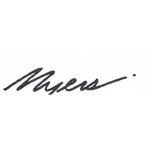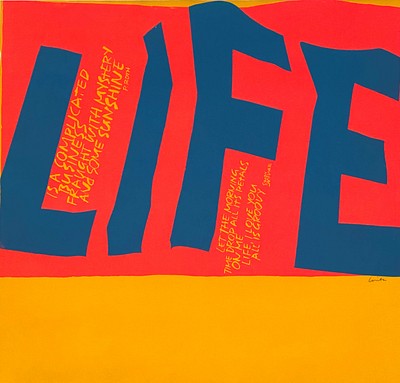Jean Albert Gorin (French, 1899-1981) Portfolio (6) Serigraph Prints
Two ways to bid:
- Leave a max absentee bid and the platform will bid on your behalf up to your maximum bid during the live auction.
- Bid live during the auction and your bids will be submitted real-time to the auctioneer.
Bid Increments
| Price | Bid Increment |
|---|---|
| $0 | $10 |
| $100 | $25 |
| $500 | $50 |
| $1,000 | $100 |
| $2,500 | $250 |
| $5,000 | $500 |
| $10,000 | $1,000 |
| $15,000 | $2,500 |
| $50,000 | $5,000 |
| $100,000 | $10,000 |
About Auction
Apr 30, 2023
Fine Art Auction - 35th Anniversary Myers Antiques auctions@myersfineart.com
- Lot Description
Jean Albert Gorin (French, 1899-1981) Print - Multiple (6) Serigraph Portfolio. Sheet size measures 27.5 inches high, 27.5 inches wide. Each serigraph is signed on the lower right. Various editions. Most are 24/100, one is an Artists Edition. The portfolio was gifted to Leon Polk Smith (1906-1996) and his life partner and assistant Robert Jaminison with a 1987 letter from Edition Und Galerie A. Hoffmann. In good condition with light foxing on the cover and cover pages and two of the serigraphs.
From Wikipedia.com: Albert Jean Gorin (1899-1981) was a French neoplastic painter and constructive sculptor. He was a disciple of Piet Mondrian, and remained true to the concept of rigid geometricism and use of primary colors, but pushed the limits of neoplasticism by introducing circles and diagonals. He was known for his three-dimensional reliefs.
Albert Jean Gorin was born on 2 December 1899 in Saint-Emilien-de-Blain, Loire-Atlantique. His father made shoes and his mother managed a small hotel with a restaurant. He attended the Ecole des Beaux-Arts in Nantes in 1914-66. After the end of World War I (1914-18) he studied at the Academie de la Grande Chaumiere in Paris from 1919-22. He was influenced by Henri Matisse, Vincent van Gogh, Paul Cezanne and the Expressionists. Gorin was unable to obtain a job teaching drawing. He settled in Nort-sur-Erdre, near Nantes and began painting, while working to earn a living.
In 1923 he discovered cubism, and was strongly influenced by the book Du Cubisme (1921) by Albert Gleizes. For a period he painted in cubist style. In 1925 he made his first abstract painting. As an extension of Cubist aesthetics he became interested in furniture design and avant-garde architecture. In 1925 Gorin visited the International Exposition of Modern Industrial and Decorative Arts in Paris where the Pavillon de L'Esprit Nouveau showed work by Amedee Ozenfant and Le Corbusier. For a short period he experimented with Purism.
In 1926 Gorin saw for the first time one of Piet Mondrian's neoplastic compositions, and one of Theo van Doesburg's elementarist compositions. He read the pamphlet L'Art et son avenir by Georges Vantongerloo. This led to correspondence with Mondrian and Vantongerloo, and then a meeting with Mondrian the same year, the start of a long friendship. Gorin also met Michel Seuphor, an art critic. Around this time Gorin began painting in the neoplastic style. Gorin's oil on cardboard Composition no. 10 (1926) is an early example of his neoplastic style. It is diamond-shaped, reflecting the influence of Mondrian, and the very thick lines are similar to van Doesburg's work. Gorin exhibited for the first time in April 1928 at Lille with the S.T.U.C.A.. Others at this show included Mondrian and Cesar Domela. In 1930 Gorin participated in the first exhibition of Seuphor's recently founded Cercle et Carre group. At the opening of the exhibition he met Jean Arp, Sophie Taeuber-Arp, Wassily Kandinsky, Otto Freundlich, Joaquin Torres Garcia and Vantongerloo. Mondrian apparently considered that reliefs were a natural step in the evolution of painting towards architecture. He encouraged Gorin to make reliefs. Gorin began to explore neoplastic architecture and decoration. He created his first neoplastic relief in 1930, and created three-dimensional work for the remainder of the inter-war period. Mondrian praised Gorin's relief work highly, saying it went further than he himself had taken painting. In 1931 Gorin was one of the founders of the 1940 association of artists. He exhibited there with Mondrian and Theo van Doesburg. He also participated in the new Abstraction-Creation group of painters. In 1932 he went to the Soviet Union to study art and architecture. On the way he met Naum Gabo in Berlin. Later he met constructivist architects Moisei Ginzburg and Konstantin Melnikov. The work of the Russian constructivist Kazimir Malevich was to have a major influence on his work, if secondary to that of Mondrian. In 1934 Gorin joined the Association Abstraction-Creation. In 1936 Gorin helped edit the last issue of the Abstraction-Création—Art Non-Figuratif almanac, for a membership of almost four hundred. In 1937 he sold his house in Nort-sur-Erdre and destroyed much of his work, then moved to Le Vesinet. During World War II (1939-45) Gorin was conscripted into the army. He became a prisoner of war in 1942. After being released, in 1944 Gorin resumed painting. He also began creating reliefs using planes set in space, and continued to study architecture. He settled in Grasse for a while, where he had a shop in which he sold objects d'art and decoration.
In 1946 Gorin, Auguste Herbin and Albert Gleizes launched the Salon des Réalités Nouvelles, the first of a series of annual exhibitions devoted to abstract/concrete/constructivist/non-figurative art. Gorin participated in many other exhibitions of abstract art in Europe and the United States. Gorin often moved in the years that followed. He would make and photograph sculptures, then destroy them since he did not have space to keep them. He did not gain full recognition until major retrospectives were held between 1965 and 1973 in Nantes, Amsterdam, Paris, Grenoble and Saint Etienne. Gorin drew up plans for a house which was built in the St. Pezenne district of Niort in 1967-68. The white cube is inconspicuous, but is essentially a neoplastic work, with interlocking geometric shapes. However, planning restrictions prevented him painting it in primary colors. The house is small, with a main room, bedroom and kitchen, and a bathroom that can only be accessed from the outside. Gorin and his wife were naturists, and ate only vegetables from his garden. Although he made the house his base for the rest of his life, he also stayed in a house he owned in Meudon, and traveled extensively. Jean Gorin died on 29 March 1981 in Niort, Deux-Sevres. His wife, Susan Gorin, died in 1995 and his property at Niort was put up for sale. Surprisingly, no effort was made to protect the house, the only one of his architectural projects to be realized.
Gorin was the greatest French disciple of Mondrian, but pushed the principles of neoplasticism further than others by using reliefs, which developed into wall sculptures. He always used the primary colors of bright red, light yellow and ultramarine blue on white and black backgrounds. His polychrome sculptures were very unusual for the time. He broke from Mondrian's rule of allowing only horizontal and vertical lines. While remaining true to neoplasticism geometric rigor, he introduced circles and diagonals. The angles may be unexpected, far from 45. Between 1958 and 1962 Gorin was absorbed in painting the contrast between the circle and the linear network. After that he returned to relief. His works were now truly three-dimensional, designed to retain harmony while viewed from different angles rather than as compositions seen only from the front. An example of later work is his Construction spatiale verticale no 101. It was made between 1968 and 1971 and is held in the French National Museum of Modern Art. A copy was made in 1983 under the direction of Serge Lemoine and is held by the University of Burgundy. The monumental sculpture is 9 meters (30 ft) high and 1.5 meters (4 ft 11 in) wide, made of carefully balanced geometric shapes of steel and aluminum painted in primary colors. Some of Gorin's works may be seen in the Musée des Beaux-Arts in Nantes and the Pompidou Centre in Paris. The Museum of Grenoble holds several hundred of his works. Exhibitions included: 1928, Lille: Neoplastic work with the STUCA group; 1929-1930: Exhibition with the Cercle et Carre group created by Michel Seuphor and Torrès-Garcia; 1930, Nantes: with the L'Etrave artistic group; 1931, Paris: Display of his first relief in an exhibition of Groupe 1940; 1945, Paris: Exposition Art Concert, Galerie Rene Drouin; 1946: Salon des Realites Nouvelles, of which he was secretary; 1948, New York: Exposition of abstract constructive art; 1957, Paris: 50 years of abstract paintings organized by the Creuze gallery. First one-man show at the Galerie Colette Allendy; 1958, Saint-Etienne: The first generations of abstract art; 1960, Liege: Musee de l'Art Wallon; 1965, Nantes: Retrospective at the Musee des Beaux-Arts; 1966, Chicago: Exposition at the Kazimir Gallery; 1967, Amsterdam: Retrospective at the Stedelijk Museum; 1969, Paris: Retrospective at the Centre national d'art contemporain; 1974, Paris: Exhibition at the Galerie Denise Rene 1977, Nantes: Retrospective at the Musee des Beaux-Arts; 1977, Paris: Centre Pompidou; 1999, Blain: Hommage du mouvement Madi a Gorin, Chateau de la Groulais; 1999, Grenoble: Exposition Jean Gorin; His writings included: Mondrian, De Stijl and their Impact, Marlborough Gallery in New York (1964) - Shipping Info
-
All shipping arrangements and costs are the sole responsibility of the buyer. We are happy to assist in the transfer of merchandise to a shipper of your choice. Buyers should request a shipping quote prior to bidding. There are reliable shipping companies to use, and they include:
(1) The UPS Store:
Charlie Mosher
301 West Platt St
Tampa, FL 33606
(813) 251-9593
store3751@theupsstore.com
www.theupsstore.com/3751For a shipping quote, click the link below to get started on a quote OR to make payment for an existing quote: MyAuctionQuote.com/myers
(2) The UPS Store:
RayAnna Brodzinski
740 4th Street North
St. Petersburg, FL 33701
(727) 513-2400
shipping@store6886.com
www.theupsstore.com/6886(3) The UPS Store:
Rian Fehrman
5447 Haines Rd N,
St. Petersburg, FL 33714
(727) 528-7777
store6173@theuspsstore.com
www.theupsstorelocal.com/6173(4) Family Pak & Ship
Amel & Mohamed Hamda
2822 54th Avenue S.
St. Petersburg, FL 33712
727 865-2320
Raman@familypakandship.com
www.familypakandship.com(5) The UPS Store:
Gina Farnsworth
204 37th Ave N.
St Petersburg, FL 33704
(727) 822-5823
store3146@theupsstore.com
www.theupsstore.com/3146(6) The UPS Store:
200 2nd Ave South
St Petersburg, FL 33701
(727) 826-6075
store3248@theupsstore.com
www.theupsstore.com/3248(7) Craters & Freighters
(813) 889-9008
Fax (813) 884-8393
Tampa@cratersandfrighters.com
www.cratersandfreighterstampa.com (U.S. & International)(8) Orbit Professional Packing Crating
(888) 247-8540 or (727) 507-7447
lg@orbitppc.com
www.orbitppc.com (U.S. & International)LARGER ITEMS SHIPPING SUGGESTIONS
For items too large for standard shipping, such as furniture:
(1) Plycon - Furniture Transportation Specialists"
(954) 978-2000 (U.S. only)
lisa@plycongroup.com
www.plyconvanlines.com
You must submit a request on-line.(2) All Directions Moving
Specialist in moving furniture from FL to NY.
941-758-3800
alldirections@comcast.net
(3) Craters & Freighters
(813) 889-9008 or (877) 448-7447
Tampa@cratersandfreighters.com
(U.S. & International).(4) Westbrook Moving LLC
Makes regular trips up and down the east coast.
(404) 877-2870
westbrookdeliveries@gmail.com(5) Eastern Express
Owner Jeff Bills makes regular trips up and down the east coast.
(843) 557-6633
jb101263@yahoo.com(6) Can Ship US
Owner makes trips from Florida to Canada
Steve Fleury (905) 301-4866
canshipus@gmail.comThere are many other local and national shippers available in our area that we can refer you to. We are not responsible for any delays on the part of this third party shipper, should there be any. We recommend shipping all items insured. Should any damage occur to items transported by a third party, we are not held responsible. In the event that an item is approved for a return, shipping is not refundable.
-
- Buyer's Premium



 EUR
EUR CAD
CAD AUD
AUD GBP
GBP MXN
MXN HKD
HKD CNY
CNY MYR
MYR SEK
SEK SGD
SGD CHF
CHF THB
THB